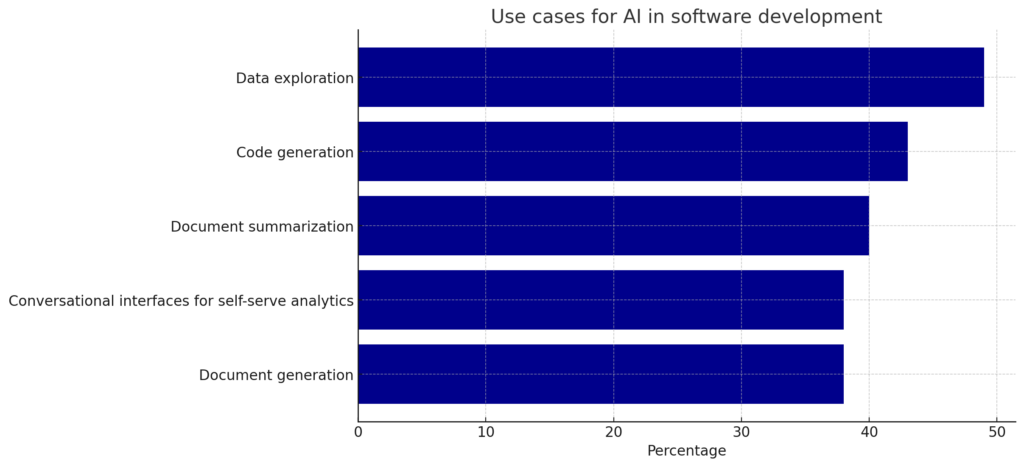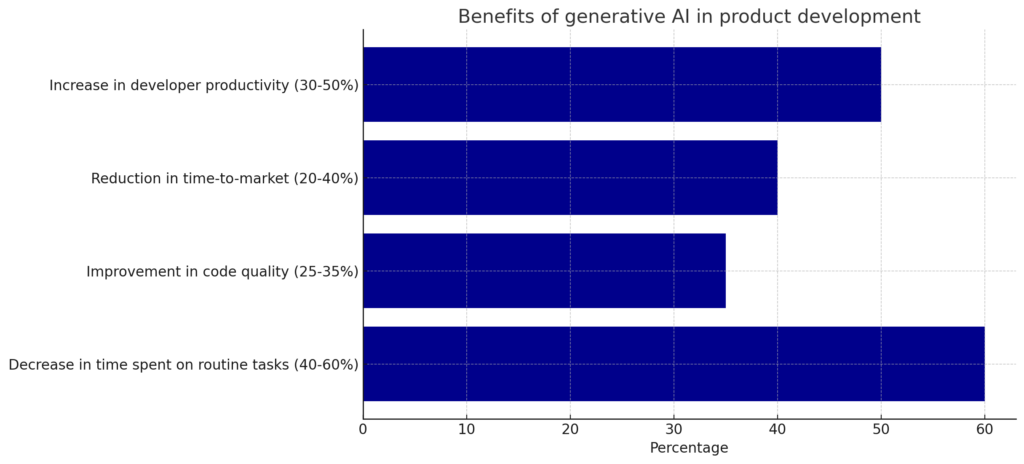-
Contents
- Why Accelerate Product Development?
- Generative AI in the Product Development Cycle
- Real-World Examples and Impact of AI in Software Development
- Final Thoughts

Why Accelerate Product Development?
Speed to Market
Early product introduction keeps organizations at an advantageous place gaining more market share than their rivals. McKinsey research reveals that companies that consistently introduce innovations are 30% more likely to be leaders in their markets. Bringing out first-rate products to the customers also increases satisfaction and loyalty since customers want new designs as soon as possible. According to a PWC survey, 73% of shoppers consider customer experience essential and how rapid product updates contribute to it.
Increased Innovation
Accelerated cycles due to AI-powered development encourage continuous iteration, enabling rapid prototyping and testing of new ideas. This fosters a culture of innovation where products are constantly refined and improved. According to Harvard Business Review, this approach increases success rates regarding innovation by 40%. AI-powered development also reduces risk as one can test an idea and if it does not work, it is easily discarded early enough so that resources are not wasted. PDMA stated that when using iterative methods, failure rates are reduced by 20%.
Driving Revenue Growth
As new products and features hit the markets at a quicker pace, companies can make money from the newest creations and grab new opportunities. A number of studies reveal that organizations that experience tightly coupled development cycles can achieve up to 25% faster business revenue growth than their counterparts with longer development cycles.
First movers also benefit from control. Dominating industry leaders secure more than seventy percent market share from new industries. It leads to products reaching customers within shorter periods as a result of accelerated development.
Improving Cost Efficiencies
Any steps taken to try and streamline the processes related to product development are beneficial in terms of using up fewer resources and less costs. Compared to the regular methodologies, the lean development approach can cut expenses by 50%.
Shortened development cycles with AI-powered development also cut costs by reducing the amount of time and human resources needed for each product. Research has shown that compressed cycles can reduce overall development costs by between 20 and 30 percent.
All in all, the concept of accelerated development results in the launching of the process at a higher speed and the enhancement of organizational performance. Those who see speed as an advantage can capture more revenue as well as create a leaner and more efficient innovation engine. This shows that the first-mover advantage is huge hence acceleration is a strategy for competitiveness.
Generative AI in the Product Development Cycle
Planning and Design Phase
AI-driven market analysis and trend prediction
Generative AI models can analyze vast amounts of market data, consumer trends, and competitor information to provide insights for product planning. Tools like GPT-4 can generate comprehensive market reports, identify emerging trends, and suggest potential product features based on current market demands.
For example, a hypothetical AI-powered market analysis tool could process millions of social media posts, product reviews, and industry reports to identify unmet consumer needs or emerging market niches. This could potentially save product managers 40-60 hours of manual research per product cycle, allowing for more informed and data-driven decision-making.
Rapid prototyping with generative AI
AI-assisted design tools can significantly accelerate the prototyping process. Platforms like Midjourney or DALL-E can quickly generate visual concepts based on text descriptions, while more specialized tools can create UI/UX wireframes or even basic functional prototypes.
A study by Gartner predicts that by 2025, AI will be involved in 80% of emerging technologies, including rapid prototyping. While specific time savings can vary, it’s reasonable to estimate that AI-assisted prototyping could reduce the time spent on initial design concepts by 30-50%, allowing teams to iterate faster and explore more design options within the same timeframe.
AI-Powered Development Phase
Library and API recommendations
AI-powered tools can analyze project requirements and existing codebase to recommend optimal libraries and APIs. For instance, GitHub Copilot X can suggest relevant packages and frameworks based on the context of the code being written.
A study by the University of Cambridge found that developers spend up to 35% of their time searching for and evaluating third-party code. AI-driven recommendations could potentially reduce this time by 40-50%, allowing developers to focus more on actual coding. Moreover, AI-powered development can help ensure the use of up-to-date and well-maintained libraries, improving overall code quality and security.
Code generation
Generative AI models like GitHub Copilot and Amazon CodeWhisperer can significantly accelerate code writing by generating entire functions, classes, or even complex algorithms based on natural language descriptions or contextual code patterns.
According to a study by GitHub, developers who used Copilot completed tasks 55% faster than those who didn’t. While results may vary depending on the task complexity and developer experience, it’s reasonable to estimate that using AI in software development (AI-assisted code generation) could save 30-40% of coding time for many common programming tasks, allowing developers to focus on more complex problem-solving and architectural decisions.
Documentation generation
AI in software development also includes automating certain documentation processes by generating code comments, API documentation, and even user manuals based on the existing codebase and natural language inputs.
Tools like Mintlify and Documatic use AI to automatically generate and maintain documentation. While specific studies on time savings are limited, it’s estimated that AI-assisted documentation could reduce the time spent on this task by 50-70%. AI-powered development not only saves developer time but also improves documentation quality and consistency, as the algorithms can ensure that documentation is updated alongside code changes.
Testing and Quality Assurance
Bug prediction and detection
AI models can analyze code patterns, commit history, and project metrics to predict potential bugs before they manifest. Tools like Amazon CodeGuru and Google’s Bug Prediction in Android use machine learning to identify areas of code that are likely to contain defects.
A study by Microsoft Research found that their AI-based bug prediction model could identify 70% of bug-prone files before release. While results may vary, it’s reasonable to estimate that AI-assisted bug prediction could reduce the time spent on debugging by 30-40%. Thus, using AI in software development saves time as well as improves overall software quality by catching issues earlier in the development cycle.
Automated test case generation
Generative AI can create comprehensive test suites based on code analysis and specifications. Tools like Diffblue Cover for Java and LLM based solutions can automatically generate unit tests, integration tests, and even complex scenario tests.
According to a report by Capgemini, AI-driven test automation can reduce test creation time by up to 80%. While this may be optimistic for all scenarios, it’s plausible that AI-assisted test generation could save 40-60% of the time typically spent on writing and maintaining test cases. This allows QA teams to focus on more complex testing scenarios and edge cases.
AI-driven performance optimization
AI can analyze application performance data to identify bottlenecks and suggest optimizations. Tools like IBM’s AI Optimization for Anomaly Detection use machine learning to detect performance issues and propose solutions.
While specific studies on time savings are limited, it’s estimated that AI-driven performance optimization could reduce the time spent on performance tuning by 30-50%. For example, Netflix reported that their AI-powered performance optimization system helped them reduce stream start times by up to 30%. Besides saving time, using AI in software development improves end-user experience and potentially reduces infrastructure costs.
Deployment and Maintenance
AI-assisted deployment strategy
Generative AI can analyze historical deployment data, system architecture, and current infrastructure to suggest optimal deployment strategies. Tools like Harness AI and IBM UrbanCode Deploy use machine learning to automate and optimize the deployment process.
While specific studies on time savings are limited, it’s estimated that AI-assisted deployment could reduce deployment preparation time by 30-40%. For instance, Harness reports that their AI-driven deployment platform has helped companies reduce deployment time by up to 90% in some cases. This not only saves time but also reduces the risk of deployment-related issues and downtime.
Predictive maintenance using AI
AI models can analyze system logs, performance metrics, and historical data to predict potential system failures or performance degradations before they occur. Platforms like Splunk and Datadog use AI to provide predictive maintenance insights.
According to a report by McKinsey, AI-driven predictive maintenance can reduce machine downtime by up to 50% and increase machine life by 20-40%. In software contexts, while results may vary, it’s reasonable to estimate that AI-assisted predictive maintenance could reduce unplanned downtime by 30-40%, significantly improving system reliability and user satisfaction.
Monitoring and feedback
AI can enhance system monitoring by automatically detecting anomalies, correlating events across different systems, and even suggesting remediation actions. Tools like Dynatrace and New Relic incorporate AI to provide more intelligent monitoring and alerting.
A case study by Dynatrace showed that their AI-powered monitoring solution helped a large e-commerce company reduce MTTR (Mean Time To Resolution) by 75%. While results may vary, it’s plausible that AI-enhanced monitoring could reduce the time spent on incident response by 40-50%, allowing teams to resolve issues faster and maintain higher system availability.
User feedback analysis and feature prioritization in AI-Powered Development
Generative AI can process and analyze large volumes of user feedback from various sources (app reviews, support tickets, social media) to identify trends, sentiment, and feature requests. Tools like Appbot and MonkeyLearn use AI to automate this process.
While specific time-saving studies are limited, it’s estimated that AI-assisted feedback analysis could reduce the time spent on manual review by 60-70%. For example, Spotify uses AI to analyze user feedback, which has reportedly helped them prioritize feature development more effectively. This AI-enabled approach ensures that product development is closely aligned with user needs and preferences.
Real-World Examples and Impact of AI in Software Development
The integration of generative AI into software development across the entire development cycle has shown remarkable results across various industries. Let’s examine some notable case studies and their quantitative impacts:
GitHub Copilot
GitHub’s internal study revealed that developers using Copilot completed tasks 55% faster than those coding without AI assistance. In a survey of over 2,000 developers:
88% reported feeling more productive
74% said they could focus on more satisfying work
77% stated that Copilot helped them spend less time searching for information or examples
“Copilot has revolutionized my coding process. I spend less time on boilerplate code and more on solving complex problems. It’s like having a senior developer always ready to assist.” – Sarah Chen, Full Stack Developer
Tabnine
Tabnine, an AI-powered code completion tool, reported significant improvements in development processes:
25-40% increase in coding speed
20-30% reduction in bugs due to AI-assisted code suggestions
15% decrease in code review time
Case Study: A mid-size fintech company implemented Tabnine and observed a 32% increase in feature delivery speed over six months. Using AI-powered development also led to a 28% reduction in reported bugs.
IBM’s AI for Code
IBM’s AI for Code initiative, which includes various AI-powered development tools, has shown promising results in enterprise environments:
50% reduction in time spent on code reviews
40% increase in developer productivity
30% decrease in defect escape rate
“AI-powered development tools have transformed our development process. We’re shipping features faster and with fewer bugs. It’s particularly helpful for maintaining and refactoring legacy code.” – Michael Patel, Senior Software Engineer at a Fortune 500 company
OpenAI’s GPT Models
While specific case studies are limited, early adopters of GPT models for documentation and test generation have reported:
60-70% reduction in time spent on writing initial documentation
40-50% increase in test coverage due to AI-generated test cases
30% reduction in time spent on updating documentation during product iterations
Case Study: A SaaS startup used GPT-3 to generate API documentation and reported a 65% reduction in documentation time, allowing them to allocate more resources to feature development.
A recent study by Gartner highlighted the primary use cases for AI in software development:

This data underscores the wide-ranging impact of AI-powered development across various aspects of the development cycle, from initial data analysis to final documentation.
Overall Impact of AI in Software Development and Future Outlook
The integration of generative AI into product development cycles has shown consistent benefits across different scales and industries:

As AI tools continue to evolve, these benefits are expected to grow. However, it’s important to note that the successful implementation of AI in software development processes often requires careful integration, training, and a willingness to adapt existing workflows.
“AI hasn’t replaced our jobs; it’s enhanced them. We’re able to focus on higher-level problem-solving and innovation while AI handles many of the time-consuming, repetitive tasks. It’s a game-changer for our industry.” – Alex Rodriguez, CTO of a rapidly growing tech startup
As generative AI continues to advance, its role in product development is likely to expand, potentially reshaping the entire software development landscape in the coming years.
Final Thoughts
Generative AI is revolutionizing product development, offering unparalleled opportunities to speed up development cycles, enhance quality, and boost productivity. By incorporating AI-powered tools at various stages, tech companies can streamline workflows, reduce time-to-market, and innovate more effectively.
In the planning and design phase, generative AI can analyze vast amounts of market data, consumer trends, and competitor information, providing actionable insights that save product managers significant time and enable more data-driven decisions. AI tools like Midjourney and DALL-E can quickly generate visual concepts and UI/UX wireframes, accelerating the prototyping process and allowing for faster iteration and exploration of design options.
During development, AI-powered development tools can suggest optimal libraries and APIs, reducing the time developers spend searching for and evaluating third-party code. Tools like GitHub Copilot can generate entire code functions and algorithms, significantly speeding up the coding process and allowing developers to focus on complex problem-solving. AI can also automate the creation of code comments, API documentation, and user manuals, improving documentation quality and saving developer time.
In testing and quality assurance, AI models can predict and identify potential bugs early, reducing the time spent on debugging and improving software quality. AI can create comprehensive test suites, saving time on test creation and maintenance, and allowing QA teams to focus on complex testing scenarios.
For deployment and maintenance, AI can suggest optimal deployment strategies based on historical data, reducing deployment preparation time and minimizing deployment-related issues. AI can analyze system logs and performance metrics to predict potential system failures, reducing downtime and improving system reliability. AI-enhanced monitoring can detect anomalies and suggest remediation actions, reducing incident response time and maintaining higher system availability.
In conclusion, generative AI transforms product development by making processes faster, more efficient, and more innovative.
Looking to shorten your product development cycle and maintain a competitive edge? Collaborate with Processica, your reliable AI partner, to fully leverage generative AI. With our proficiency in AI-powered development tools and methodologies, we can help you optimize workflows, cut expenses, and expedite the delivery of innovative products. Don’t let your competitors get ahead—reach out to Processica today and learn how we can revolutionize your product development process. Let’s innovate together!


